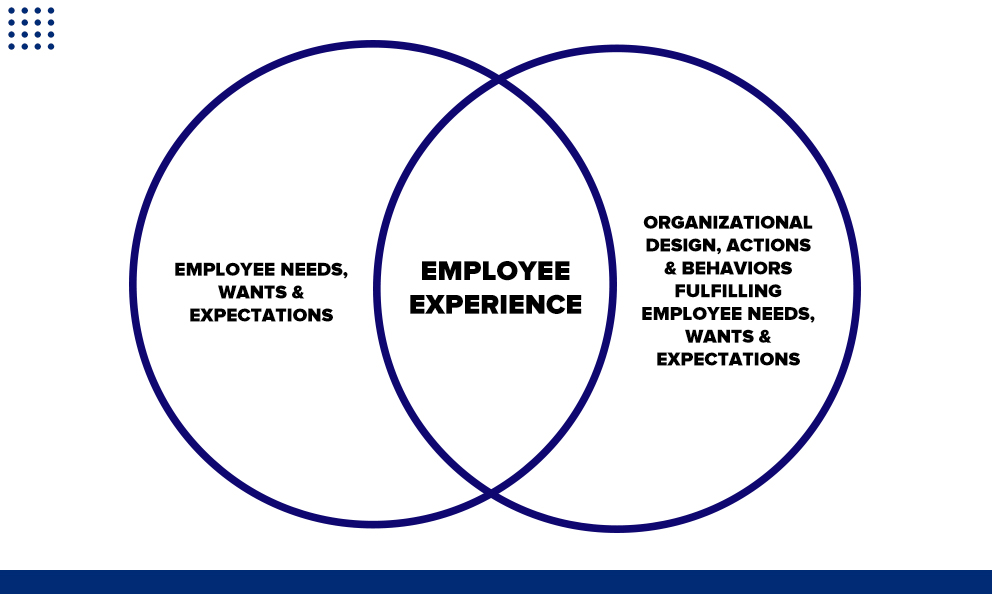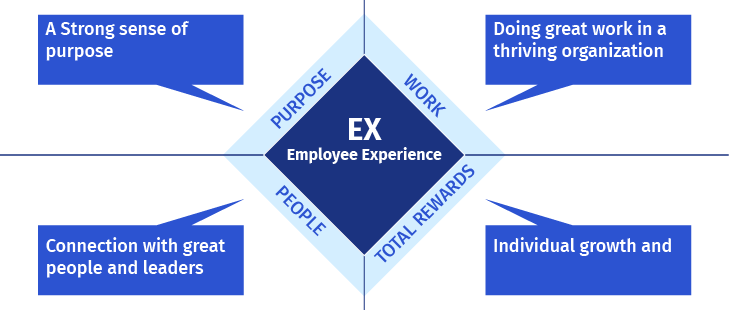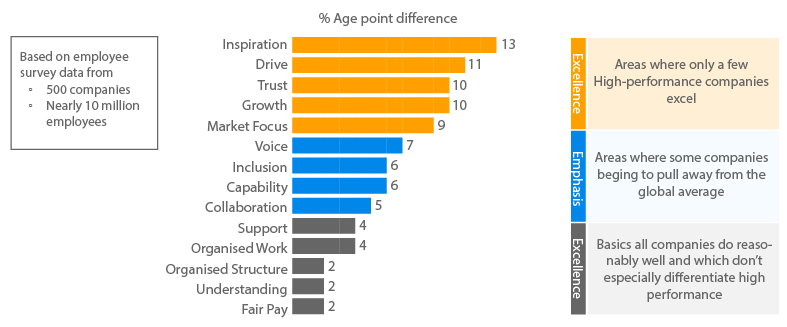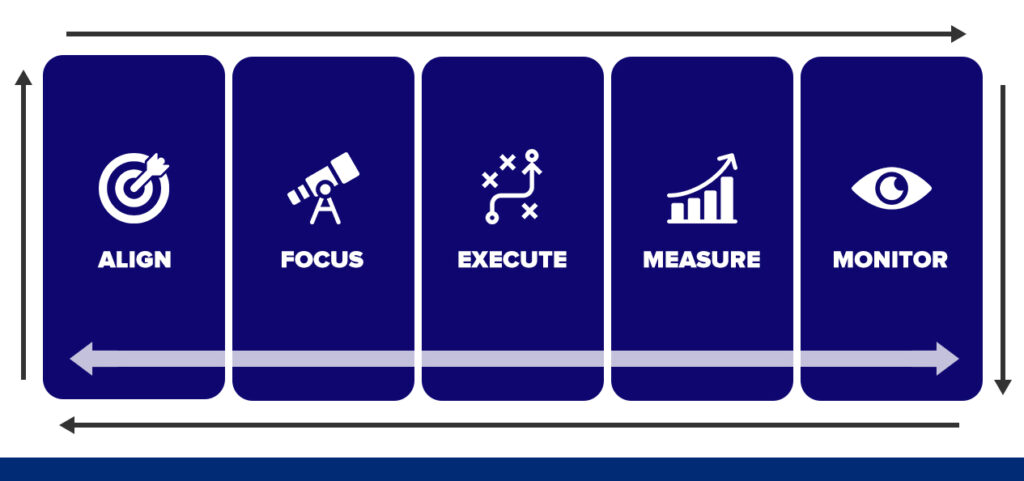“Good is the enemy of great … It is the key reason why so few become great” – Jim Collins
It is puzzling that employee experience (EX) has only recently gained traction. After all, customer experience (CX) has been around for decades, so why has it taken organizations so long to look inward—at their people—who make things happen?
The evidence for EX is strong, yet many organizations are failing at it and are unable to achieve this state in practice. Only a select few firms have executed people-first approaches, excelled at placing their employees at the core, attained the ‘elite’ status, and, in turn, are rewarded with a highly engaged, productive workforce and increased revenue and profits.
What is an “Elite”—an HPO? How do we describe this rare, unique, and often elusive state of exclusivity?
High Performing Organizations (HPOs), aka the ‘Elites,’ “are considered the best or most powerful compared to others of a similar type” (Cambridge Dictionary). They possess core traits that set them apart from the rest and typically achieve “financial and non-financial results that are exceedingly better than those of its peer group over some time, by focusing in a disciplined way on that which matters to the organization” (de Waal, 2019, p. 5). Instead of concentrating solely on outputs, such as revenue and profits, the emphasis is typically on the employees who make those outputs possible. Consequently, these firms have found the right balance between people and financial value.
n.b. It is important to note that sustainable desired results over a prolonged period characterize high performance. An ‘elite’ organization does not perform well out of sheer luck but because of an effective strategic plan with an average time horizon of three years or more to increase performance and beat the competitive peer group.
The driving force for adding value is evident in ‘elite’ organizations. Long-term strategic commitment, as opposed to short-term financial goals, is intact. Culture is actively integrated into corporate plans, and there is a conscious attempt to connect culture with people, systems, processes, and behaviors.
The Modus Operandi
Members of the ‘elite’ club have a common thread. The ‘elites’ know that core organizational capabilities and people competencies drive financial and operational performance and enable strategy. They have figured out what it takes for sustained success. So, they set their sights on the right target—their people—to achieve measurable results.
The ’elites’ employ a rare combination of people-first leadership and an employee-centered approach and effectively translate business strategy into a robust people strategy. They place the employees front and center and ensure an impactful employee experience (EX) to combat external threats, mitigate competitive forces, and achieve their goals and objectives.
Also, they are disciplined not to be distracted by the latest leadership fad and remain on track with people-centered strategic initiatives aligned with their core values, purpose, and vision.
Further, the ‘elites’ improve what makes them successful—people, processes, systems, behaviors—and strive for improvement efforts on a continuum to excel in those contexts.
The primary reason for an ‘elite’ taking a different angle and changing strategy (a deviation from the initial plan) is if an opportunity arises to strengthen its core capabilities and competencies. They know that deviating from an established path could directly impact and mean decreased engagement and declining performance, so leadership is usually keen on maintaining discipline (de Waal, 2019; Morgan, 2017; WTW, 2019).
The Key Differentiators
There are many ingredients, granted, to the secret sauce that differentiates the ‘elites’ from the rest; however, the decision is to highlight the essential contexts!
They are:
People First Leadership –Transformational leaders who invoke a people-first philosophy and signal a commitment to meeting the needs of their employees. People-first leaders realize that the employees are the decisive factor for the measurable results, so they use a people-centered design to create an employee-focused culture. It fosters an environment of trust, inspiration, loyalty, commitment, and respect in the workforce.
People-Centered Strategies – As evident, the ‘elites’ wisely focus on their ‘people’ first and places them at the core of their business strategies. They effectively translate business strategy into a robust people stratagem by attracting and retaining the most capable individuals and connecting their people with corporate strategy. It transcends a mere employee value proposition.
High Engagement Corporate Culture – The organizational culture is not accidental; it is a planned, aligned, established, managed, and regularly monitored environment designed to achieve strategic goals and objectives. As a result, regardless of job roles/positions, employees are motivated to pursue corporate goals actively beyond the call of duty.
Employee Experience Design –Looking through the lens of the employees and formulating an applicable EX. In short, creating an employee-focused organizational culture/environment based on their needs, desires, and expectations—i.e., an overlap between the employees’ reality and the organizational design, actions, and behaviors aligned with that reality (Morgan, 2017). (see Figure 1)

EX: The intersection of employees’ needs, wants & expectations and a corporate design and actions & behaviors that fulfill those needs, wants & expectations
An ‘elite’ organization knows its employees, recognizes that its employees have expectations, offers what they desire, and delivers an excellent employee experience (EX), the foundation of producing a superior customer experience (CX), and, in theory, exceptional financial performance.
Key differentiators/characteristics have allowed the ‘elites’ to consistently outperform their peers over the long term in both people and financial indices.
So, what exactly is the employee experience—EX?
Defining EX
EX has many definitions; it is a broad and fluid term that is defined differently depending on the context in which the nomenclature is depicted.
From a human resource management (HRM) perspective, EX refers to the totality of encounters, observations, and emotional responses felt by an employee due to multiple workplace tasks, processes, protocols, and behaviors during his/her tenure in an organization. In essence, it is an employee’s experience through various touchpoints—from the recruitment process, through the employee lifecycle, to the offboarding/outplacement stage.
Dery & Sebastian (2016) view EX “as the work complexity and behavioral norms that influence employees’ ability to create value” (para. 4).
Morgan (2017) describes EX as “the intersection of employee expectations, needs, and wants and the organizational design of those expectations, needs, and wants” (p. 8).
Willis Towers Watson (2019) views EX as (a) “connecting with people and organizational purpose” and (b) “contributing to work and being rewarded accordingly” (p. 2).
Massachusetts Institute of Technology (MIT) Center for Information Research (2022) defines EX as “The extent to which employees are enabled or constrained by the work environment and work habits to do their jobs today and to re-imagine their jobs of tomorrow” (para. 6).
Gartner (2023) declares, “Employee experience is the way in which employees internalize and interpret the interactions they have with their organization, as well as the context that underlies those interactions” (para. 1).
Deloitte (2023) explains EX as “the human connections and mechanisms that create a high level of purpose and meaning between workers and the organization. At the core of any human experience is the desire to belong, feel connected with others, and contribute to something of significance and value” (para. 3).
So, it is evident there is no clear definition; however, the constants are organizational design & behavior, corporate culture, and workplace environment. It is about the overall experience throughout an employee’s lifecycle. A highly positive EX contributes to engagement, motivation, performance, and job satisfaction, whereas a highly negative EX could have an adverse effect.
The EX Factor
So, what does it take to create and foster an excellent employee-focused workplace and deliver the desired EX? Young and Kulesa (2019)—Willis Towers Watson (WTW)—offer some insights!
Based on extensive and reliable research, WTW developed an evidence-based model of EX, identifying the four factors that matter most to employees. (see Figure 2)
They are …
- Purpose – A strong sense of purpose
- People – Connecting with great people and leaders
- Work – Doing great work in a thriving organization
- Total Rewards – Growth & Reward opportunities in return

Note. Adapted from Breakthrough research: Identifying the factors that make a high-performance employee experience (HPEX), by S. Young and P. Kulesa, 2019, Willis Towers Watson, Copyright © 2017 by Willis Towers Watson.
Each dimension contributes to an organizational culture—its DNA—the beliefs, values, and practices that guide behaviors. Consequently, a firm’s cultural framework directly affects its EX, customer experience (CX), shareholder value, business-partner relationships, and business results.
Along the four dimensions—People, Purpose, Work & Total Rewards—the EX-factor that tops the employees’ list are: Inspiration, Drive, Trust, Growth & Market Focus. (see Figure 3)

Global High-Performance norm companies vs. Global average (% favorable)
Note. Adapted from Breakthrough research: Identifying the factors that make a high-performance employee experience (HPEX), by S. Young and P. Kulesa, 2019, Willis Towers Watson, Copyright © 2017 by Willis Towers Watson
The ‘elites’ excel in these areas and generally set themselves apart from their peers with the key differentiators shared prior. They are unique because of their people-first leadership, people-centered strategies, high-engagement corporate culture, and EX design, which lead to inspiring employees, building trust, helping employees achieve their potential, and being agile and innovative in the marketplace.
As evident, the key differentiators go far beyond the basics of rewards and tend to be more philosophically based—a people-first mindset—and woven into the organization’s culture. While rewards and other benefits (tangible & intangible) are vital, they are supplementary to the EX.
The Data
WTW discovered that the dimensions—People, Purpose, Work & Total Rewards—determine whether an organization will underperform or outperform its peers. There is a direct correlation between EX and business results. EX predicts sustained financial success, and the ‘elites’ have impressive and sustained performance. They outperform their peers for top-line growth, bottom-line profitability, and shareholders’ return. (see Figure 4)

Note. Adapted from Breakthrough research: Identifying the factors that make a high-performance employee experience (HPEX), by S. Young and P. Kulesa, 2019, Willis Towers Watson, Copyright © 2017 by Willis Towers Watson.
WTW also found that people-centered organizations are:
- 3x as likely as other organizations to report employees are highly engaged.
- 93% more likely to report significantly outperforming their industry peers financially.
- 10% less likely to report difficulty attracting and retaining key employee segments.
Other Supporting Evidence
Despite a shortage of scientific research, various case studies (including the WTW research) and business reports have documented the vital benefits of EX design and application.
Research by Jacob Morgan (2017) of 250 diverse organizations reveals companies that invest in EX outperform their competitors. These firms have “more than four times the average profit, more profitable and more than two times the average revenue” (para. 6). Additionally, they outperformed the S&P 500 and the NASDAQ and are often showcased in Fortune’s 100 Best Companies to Work.
An MIT study by Dery & Sebastian (2016) produced similar findings, observing that EX predicts business performance. Companies in the top quartile for EX are determined to be 25% more profitable, have twice the innovation, and double the CX than competitors.
Also, Gallup (2019) discovered that firms with highly engaged employees have more than four (4)times the earnings-per-share (EPS) growth rate of those with low engagement scores. They also have 21% higher profitability and substantially better customer engagement, productivity, and employee retention.
Additionally, a study by The Josh Bersin Company (2021) uncovered that “Level 4” companies (the ‘elites’)—i.e., those that offer the most robust EX, compared to their peers, have 20% more equitable growth.
Further, McKinsey & Company (2021) research found a strong correspondence between employees’ stated needs and the underlying drivers of their engagement, well-being, and work effectiveness.
Finally, Gautier et al. (2022), Harvard Business Review, established a causal link between EX, CX, and business outcomes—revenue and profits. The data reveal that EX drives revenue.
Based on the data, there is a direct linkage between EX, employee engagement, and workforce potential that drives high employee productivity and increases corporate performance and financial returns. There is undeniably a significant return to organizations focusing on EX over the long term, not just short-term employee engagement in the here and now.
So, how do organizations become a member of the ‘elite’ club and achieve ‘excellence’ status? It requires adopting a new mindset, rethinking the work experience, and crafting an appropriate EX strategy!
Designing an EX Strategy
Creating the EX is not a process but a corporate strategy. Since EX includes touchstones that cover the entire employee lifecycle journey, leaders need to see employees as customers and create an environment that allows them to thrive in the workplace and their careers. A well-designed and executed EX strategy could fit the bill. To that end, when drafting an EX strategy, the key is enhancing the workforce experience spanning multiple functions/departments/units/teams/workgroups. It is an organizational-wide employee initiative, not for a select few!
A core framework with the vital elements of an EX strategy is essential to serve as a blueprint for success. This article provides a basic framework. (see Figure 5)

Align: Develop experience vision aligned with talent and business strategies
Focus: Define and brand the end-to-end employee experience
Execute: Implement prioritized initiatives roadmap with targeted people & business strategies
Measure: Capture the value and find and implement enhancements
Monitor: Review progress daily, identify risks, and offer solutions to unexpected outcomes
n.b. The implementation and measurement of EX are like an audit of the corporate culture and current workplace environment. It is a continuous process, not a one-time initiative.
Design an EX-framework to meet the employees’ needs, desires, and expectations that align with the DNA—core values, culture, goals, mission, and vision of the enterprise. The EX-framework should be company-specific and translated by leaders to the precise organizational situation in its current state.
Once the strategic framework has been planned and crafted, the implementation and change management journey can begin to ensure a distinct, impactful, and lasting EX effect.
An EX-Roadmap
“The change management journey has many obstacles and challenges; however, the destination will be reached by staying the course” Karen Wagner-Clarke.
First, it is crucial to preface this roadmap by stating that EX is not an event; it is not a project; it is not a process; it is a cross-functional strategy that covers the entire employee lifecycle.
Second, assuming one employee-improvement action magically moves the organization to deliver excellent EX is unwise.
Third, each company has its DNA, so the best practices at one company may not work at your organization. Therefore, the EX design should be company-specific and the best fit for the enterprise. (see Figure 1)
Fourth, an impactful EX cannot be created and implemented in a day; it is a long-term plan that should align with the firm’s core values, goals, and objectives, be thoughtfully developed, and be adopted over time.
The goal is to create a corporate mindset, state, and employee reality to build a community of highly engaged, committed employees eager to work towards a common mission and vision. The result will likely be an enriched EX, elevated CX, enhanced productivity, increased profits, and high return on investments (ROI).
n.b. The roadmap intends to serve as a core guide, nothing else! It offers actionable insights and advice for leaders who want to implement effective practices to drive EX excellence.
Recommendations:
Getting out of the comfort zone: Abandoning the traditional idea of wanting to achieve higher turnover, revenue, and profit growth. Instead, broadening the horizon and rethinking the workplace and EX by placing people as the core strategy will eventually translate into increased growth and profitability.
Instilling shared purpose: Employees want to feel invested in their organization’s purpose and ultimate objective. So, institute regular meetings to discuss emerging issues and create a framework for addressing them and deciding ‘why,’ ‘what,’ ‘how,’ and ‘when.’ Also, create a protocol for sharing the results specifically, timely, and transparently throughout the organization.
Being employee-centric: Placing the needs and expectations of the employees as the focus of the organization’s operations. An ‘employee-centric’ environment means prioritizing psychological safety, accountability, engagement, autonomy, and creativity. The employees become the top priority!
Creating a workplace culture where everyone feels valued: While every organization has its recipe, prioritizing people’s value over financial value—should always be the secret ingredient. From involving employees in the decision-making process and garnering ‘buy-in’ to providing support to achieve their full potential, leaders should make the workforce feel that their needs, desires, and expectations are prioritized. Creating the right workplace environment and state for employees to excel!
When employees feel valued and considered more important than profit margins, it increases their motivation, engagement, satisfaction, and performance. Engaged employees work passionately, feel connected to the company, and help move the organization toward excellence.
Linking Culture with Systems & Processes: It means adapting a collaborative ‘systems thinking’ approach and creating seamless experiences with cross-functional and cross-enterprise (when applicable) workflows to connect people, places, functions, systems, and processes and achieve better business outcomes.
Fostering psychological safety: Having a culture grounded in psychological safety makes it easier for people to take interpersonal risks, raise their concerns, voice their perspectives, and challenge the status quo. In addition, it means creating a high-performance zone of high psychological safety and accountability, which allows employees to create, innovate, and strive for excellence.
Promoting personal & professional growth & development: Most organizations offer programs to foster professional growth and development; however, employees also want opportunities for personal growth, for example, implementing career coaching, external training courses, certifications, language lessons, and community service programs. Broadening the definition of ‘employee development’ provides opportunities to increase employees’ skills and performance. Learning something new, even when not directly work-related, hones employees’ learning skills. It is a winning proposition for both employees and employers!
Listening to the voice of the employees: Actively listening to employees about their needs, desires, and expectations is imperative. It is best to take the time to monitor behaviors, send out surveys, listen to ideas, and have casual meetings and conversations. Also, take a genuine interest in what employees are doing to gain deeper insights that will help to better inform where the firm’s people-centered approach should be focused. Then, act proactively on the knowledge gained to improve their work experience!
Suggestion: The proposal is to replace annual or biannual employee engagement surveys with an ongoing pulse, organizational culture, business process feedback surveys, and open feedback platforms to capture employee feedback on a continuum. Include candidate interviews; engagement, employee satisfaction, and EX surveys; ongoing performance conversations; quarterly, semi-annual, or annual performance reviews; and exit interviews to gather a real-time understanding of employee issues. When reviewing the results, contemplate these questions:
- How do our employees feel about the workplace culture/environment?
- Is the organization living up to the employees’ expectations?
- What have we learned based on the responses?
- What improvements could be made to meet our employees’ needs and expectations?
EX efforts should build a continuous flow of feedback (a feedback loop) between leadership and the workforce. In this manner, leadership is aware of those aspects of the EX that are working well and areas requiring improvements.
Emphasizing the employee experience: The ‘people-first’ philosophy and EX initiative should be woven into the company’s DNA and emphasized throughout the employee lifecycle. Leaders should ensure that all programs, processes, protocols, and strategies are developed and implemented, keeping employees front and center to facilitate a culture that takes care of its people from hire to departure/retirement. EX is a cross-functional strategy spanning all units, teams, and work groups!
In Summary
Undoubtedly, the ‘elites’ have discovered ways to enrich the EX, leading to purposeful, productive, meaningful work. They provide employees with an all-encompassing encounter supported by a people-first cross-functional strategy that makes a difference.
Delivering a firm’s EX-factor, achieving workforce excellence, and distinguishing an organization as an ‘elite’ is rare but not impossible! Nevertheless, joining the ‘elite’ club and being an employer of choice requires looking beyond the traditional perks and programs companies have long touted as differentiators. Instead, it necessitates focusing on the EX factors that matter to your workforce, delivering the best EX, and meeting the employees’ needs, desires, and expectations.
After all, “In a world where money is no longer the primary motivating factor for employees, focusing on the employee experience is the most promising competitive advantage that organizations can create!” – Jacob Morgan, The Employee Experience Advantage
References
Cambridge Dictionary. (n.d.). Elite. In Cambridge Dictionary.org. Retrieved May 2, 2023, from https://dictionary.cambridge.org/us/dictionary/english/elite
Collins, J. (2001). Good to Great: Why some companies make the leap and others don’t Hardcover. New York, NY: HarperCollins.
de Waal, A. (2019). What makes a high-performance organization: Five validated factors of competitive advantage that apply worldwide. Amsterdam, Netherlands: Warden Press.
Deloitte (2023). Elevating the workplace experience: The importance of employee engagement and meaningful work. https://www2.deloitte.com/us/en/pages/human-capital/articles/elevating-workplace-experience.html
Dery, K. & Sebastian, I. M. (2017). Building business value with employee experience: Massachusetts Institute of Technology Center for Information Systems Research. https://cisr.mit.edu/publication/2017_0601_EmployeeExperience_DerySebastian
Gallup (2019). Employee Engagement on the Rise in the U.S. https://news.gallup.com/poll/241649/employee-engagement-rise.aspx
Gartner (2023). Gartner Glossary: Employee Experience. https://www.gartner.com/en/human-resources/glossary/employee-experience#:~:text=Employee%20experience%20is%20the%20way,context%20that%20underlies%20those%20interactions.
Gautier, K., Bova, T., Chen, K. & Munasinghe, L. (2022). Research: How Employee Experience Impacts Your Bottom Line. Harvard Business Review. https://hbr.org/2022/03/research-how-employee-experience-impacts-your-bottom-line
Massachusetts Institute of Technology (MIT) (Dec 13, 2022). Exploring the employee experience. https://news.mit.edu/2022/exploring-employee-experience-nick-van-der-meulen-1213
Morgan, J. (2017). Why the Millions We Spend on Employee Engagement Buy Us So Little. Harvard Business Review. https://hbr.org/2017/03/why-the-millions-we-spend-on-employee-engagement-buy-us-so-little.
Morgan, J. (2017). The employee experience advantage: How to win the war for talent by giving employees the workspaces they want, the tools they need, and a culture they can celebrate. Hoboken, NJ: Wiley & Sons.
Young, S. & Kulesa, P. (2019). Breakthrough research: Identifying the factors that make a high-performance employee experience (HPEX). Willis Towers Watson. https://www.wtwco.com/en-GB/Insights/campaigns/breakthrough-research-on-employee-experience


